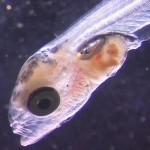 Description:
Description:
There are over 40,000 different species of fish in the world, and we are still discovering new species each year. In addition to making up a majority of vertebrates on the planet, we as humans enjoy eating fish as well. Learn from local scientists about fish morphology and diversity, how scientists study the different life stages of fish, and how we can learn where fish have been from their “ear bones” (otoliths). Also, the diversity of forms and characteristics of fish larvae is remarkable. Through hands-on activities, lab and field experiences, and discussions with fish biologists learn more about this fascinating group of vertebrates and ways to bring them into your ocean teaching. Also, discuss the human interactions with and impacts on fishes. Practice your observational and critical thinking skills at each stop to bring them into your teaching.
In addition, we will spend the afternoon discussing ways that the Education & Outreach team at IMCS can best serve and support ocean-interested teachers throughout New Jersey.
Program & Materials:
Fish Aging – Dr. Paola Lopez-Duarte
Fish Aging Lesson Plans
** Introduction to Fish Aging Presentation – Coming Soon.
How Old Are You? Lesson Plan for Elementary & Middle School Level
How Old is that Black Sea Bass? Lesson Plan Middle & High School Level
Fish Diet Analysis – Dr. Paola Lopez-Duarte, Mikaela Provost
Fish Diet Analysis Lesson Plans
** Introduction to Fish Diet Analysis Presentation – Coming Soon.
Fish Form & Function – Inside & Out Lesson Plan Elementary & Middle School Level
What Have You Been Eating? Lesson Plan Middle & High School Level
Fish Tracking – Dr. Thomas “Motz” Grothues
Fish Tracking Lesson Plans
** Introduction to Fish Tracking Presentation – Coming Soon.
COOL Classroom’s Fish Migration Unit Plan Elementary & Middle School Level or visit the COOL Classroom Fish Migration activity homepage
Tracking Juvenile Summer Flounder Lesson Plan Middle & High School Level
